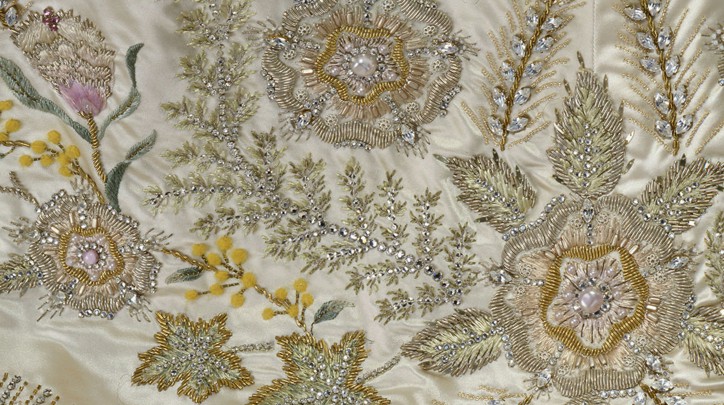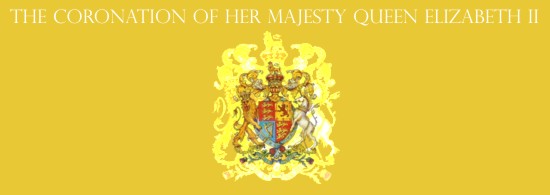

The moment that brought the magnificent sight of Her Majesty the Queen stepping out of the Gold State Coach and into the Annex was also the moment in which it was possible to see the splendorous dress designed and made for her by Norman Hartnell, who had designed her wedding dress and other important dresses. A magnificent piece of art and history, complemented with some stunning jewels with an history of their own.
 A splendid detail of the embroidery on Queen Elizabeth II’s stunning Coronation Dress, by Norman Hartnell, a piece of art and history. The Queen understood it was appropriate to enclose symbols of the countries part of the United Kingdom and the Empire. The flowers represented England, Scotland, Wales, Northern Ireland, Canada, India, New Zealand, Australia, Pakistan and South Africa.
A splendid detail of the embroidery on Queen Elizabeth II’s stunning Coronation Dress, by Norman Hartnell, a piece of art and history. The Queen understood it was appropriate to enclose symbols of the countries part of the United Kingdom and the Empire. The flowers represented England, Scotland, Wales, Northern Ireland, Canada, India, New Zealand, Australia, Pakistan and South Africa.
 The original design of Hartnell was the dress with the flowers representing the countries of the United Kingdom, embroidered in silver. From the eight designs presented by the designer, that was the Queen’s favourite but Her Majesty thought it was too similar to her wedding dress, also designed by Hartnell: that is why it was made colourful.
The original design of Hartnell was the dress with the flowers representing the countries of the United Kingdom, embroidered in silver. From the eight designs presented by the designer, that was the Queen’s favourite but Her Majesty thought it was too similar to her wedding dress, also designed by Hartnell: that is why it was made colourful.
 A closer look at the Coronation Robe, worn by the Queen as she left Westminster Abbey, embroidered in gold.
A closer look at the Coronation Robe, worn by the Queen as she left Westminster Abbey, embroidered in gold.
 This fantastic piece of jewellery, made in diamonds and pearls, was executed on the orders of King George IV and was it possibly worn by him at his coronation, over a large plumed hat. Some sources, nevertheless, say the King never wore it, for the diadem was judged too feminine. The circular diadem is decorated with four crosses-pattées, set with diamonds, representing St. George, the front one with a wonderful honey-coloured diamond in the centre. The four bouquets of flowers in diamonds include roses, thistles and shamrocks, representing England, Scotland and Ireland. Wales, being a principality, was not represented. Below, two rows of pearls with diamonds in the middle make it one of the finest pieces of jewellery of the royal collection. It is part of the Crown Jewels since the death of HM Queen Victoria, who left it to the Crown in her will. The diadem was never used by a male royal again, only by queens, consorts and regnant, from Queen Adelaide to Queen Elizabeth II.
This fantastic piece of jewellery, made in diamonds and pearls, was executed on the orders of King George IV and was it possibly worn by him at his coronation, over a large plumed hat. Some sources, nevertheless, say the King never wore it, for the diadem was judged too feminine. The circular diadem is decorated with four crosses-pattées, set with diamonds, representing St. George, the front one with a wonderful honey-coloured diamond in the centre. The four bouquets of flowers in diamonds include roses, thistles and shamrocks, representing England, Scotland and Ireland. Wales, being a principality, was not represented. Below, two rows of pearls with diamonds in the middle make it one of the finest pieces of jewellery of the royal collection. It is part of the Crown Jewels since the death of HM Queen Victoria, who left it to the Crown in her will. The diadem was never used by a male royal again, only by queens, consorts and regnant, from Queen Adelaide to Queen Elizabeth II.
 Some details of the State Diadem.
Some details of the State Diadem.
 On the left, Her Majesty Queen Mary in full court dress wearing the King George IV State Diadem, which holds a mantilla in place. Queen Mary, as well as her mother-in-law Queen Alexandra, pictured on the right in bejewelled splendour wearing the same circlet, were known for their love for jewels and the lack of complex on the time of appearing with jewels all over their dresses. It was thanks to their love for jewels that the jewellery collection of the Royal Family grew to its present state.
On the left, Her Majesty Queen Mary in full court dress wearing the King George IV State Diadem, which holds a mantilla in place. Queen Mary, as well as her mother-in-law Queen Alexandra, pictured on the right in bejewelled splendour wearing the same circlet, were known for their love for jewels and the lack of complex on the time of appearing with jewels all over their dresses. It was thanks to their love for jewels that the jewellery collection of the Royal Family grew to its present state.
 Above, the Queen Victoria’s Collet necklace and the earrings worn by the Queen at the Coronation, which do also belong to the Crown, on the wish of HM Queen Victoria who so stipulated in her will. The necklace and earrings were made in 1858 with 28 splendid collet diamonds taken from a Garter badge and a ceremonial sword. The pendant stone is known as the Lahore Diamond.
Above, the Queen Victoria’s Collet necklace and the earrings worn by the Queen at the Coronation, which do also belong to the Crown, on the wish of HM Queen Victoria who so stipulated in her will. The necklace and earrings were made in 1858 with 28 splendid collet diamonds taken from a Garter badge and a ceremonial sword. The pendant stone is known as the Lahore Diamond.
 A formal picture of Queen-Empress Victoria wearing the necklace and earrings made for her in 1858. A small circlet of diamonds holds a white lace mantilla. This extremely regal picture was made in 1893 but it was released in 1897 to mark the Diamond Jubilee of Her Majesty.
A formal picture of Queen-Empress Victoria wearing the necklace and earrings made for her in 1858. A small circlet of diamonds holds a white lace mantilla. This extremely regal picture was made in 1893 but it was released in 1897 to mark the Diamond Jubilee of Her Majesty.

Index Page
Previous Page










